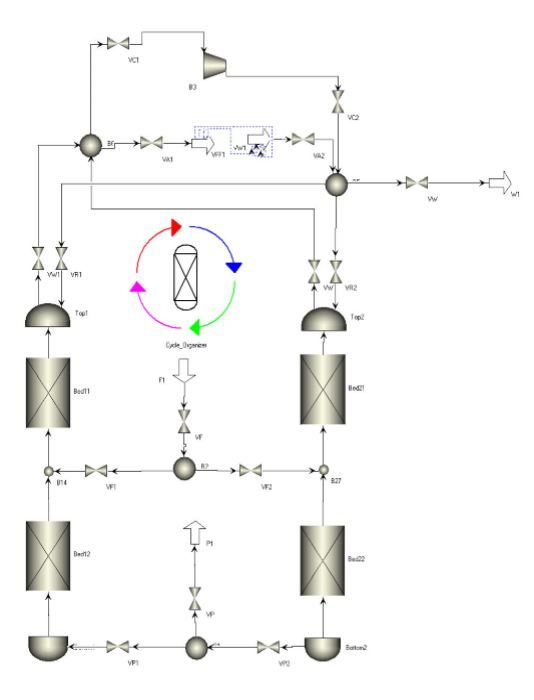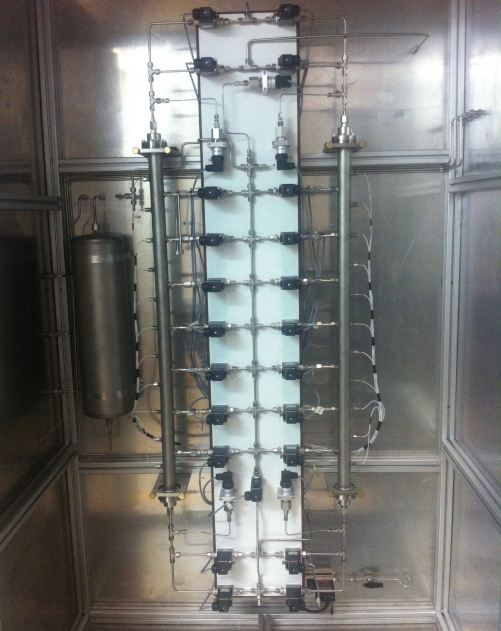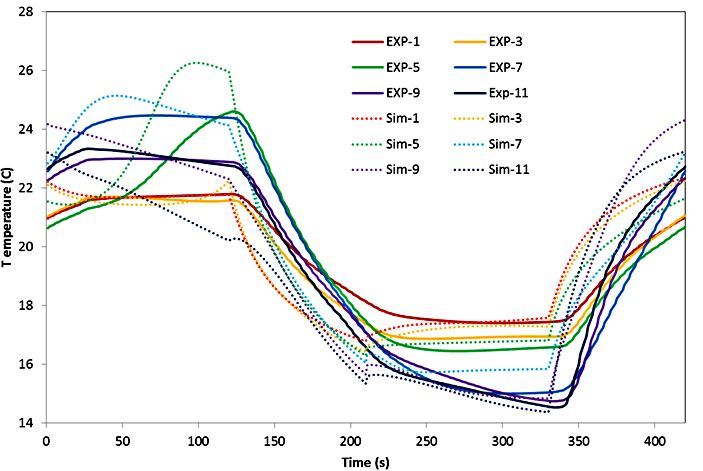
Modelling dual reflux pressure swing adsorption (DR-PSA) units for gas separation in natural gas processing
George Zhang, Department of Chemical and Materials Engineering
Pressure swing adsorption is an alternative gas separation method using adsorption to separate gas mixtures. DR-PSA is an advanced configuration of pressure swing adsorption with two product refluxes and an internal loop. DR-PSA can achieve perfect separation in theory.
Dynamic modelling of adsorption units is considerably hard. Material balance, energy balance, heat transfer, mass transfer has to be considered in dynamics, thus rigorous numerical models are often built using a dedicated simulator: Aspen Adsorption. Aspen Adsorption is a module of the Aspen Suite and has built-in partial differential equations for mass balance, energy balance as well as adsorption isotherms. Besides these, Aspen Adsorption can model pressure-flow networks in a rigorous way.
Conventional PSA usually contain two columns working in parallel – one in adsorption mode and the other in regeneration mode. To simplify the model in Aspen Adsorption, it introduced an “interaction unit” to decrease computational intensity.
However DR-PSA has two refluxes and four adsorption parts thus four adsorption columns need to be independently and simultaneously simulated while the pressure-flow relationships of the system also has to be guaranteed. Besides these, the stiff manner of the system requires the integrator step size to be very small (as low as 1E-5 seconds), otherwise the integrator would either crash or result in a wrong predicted value.

Figure 1: The model built in the Aspen Adsorption for simulation

Figure 2: The experimental 2-column setup
This research is performed in collaboration with the University of Western Australia, where they perform the experiments. Figure 3 below shows the results of a temperature distribution comparison between experiment and simulation. There is a very good agreement, which could only be obtained thanks to the computational power provided by the VM.

Figure 3: Temperature profile comparison – Vinlet spec
See more case study projects

Our Voices: using innovative techniques to collect, analyse and amplify the lived experiences of young people in Aotearoa

Painting the brain: multiplexed tissue labelling of human brain tissue to facilitate discoveries in neuroanatomy

Detecting anomalous matches in professional sports: a novel approach using advanced anomaly detection techniques

Benefits of linking routine medical records to the GUiNZ longitudinal birth cohort: Childhood injury predictors

Using a virtual machine-based machine learning algorithm to obtain comprehensive behavioural information in an in vivo Alzheimer’s disease model

Mapping livability: the “15-minute city” concept for car-dependent districts in Auckland, New Zealand

Travelling Heads – Measuring Reproducibility and Repeatability of Magnetic Resonance Imaging in Dementia

Novel Subject-Specific Method of Visualising Group Differences from Multiple DTI Metrics without Averaging

Re-assess urban spaces under COVID-19 impact: sensing Auckland social ‘hotspots’ with mobile location data

Aotearoa New Zealand’s changing coastline – Resilience to Nature’s Challenges (National Science Challenge)

Proteins under a computational microscope: designing in-silico strategies to understand and develop molecular functionalities in Life Sciences and Engineering

Coastal image classification and nalysis based on convolutional neural betworks and pattern recognition

Determinants of translation efficiency in the evolutionarily-divergent protist Trichomonas vaginalis

Measuring impact of entrepreneurship activities on students’ mindset, capabilities and entrepreneurial intentions

Using Zebra Finch data and deep learning classification to identify individual bird calls from audio recordings

Automated measurement of intracranial cerebrospinal fluid volume and outcome after endovascular thrombectomy for ischemic stroke

Using simple models to explore complex dynamics: A case study of macomona liliana (wedge-shell) and nutrient variations

Fully coupled thermo-hydro-mechanical modelling of permeability enhancement by the finite element method

Modelling dual reflux pressure swing adsorption (DR-PSA) units for gas separation in natural gas processing

Molecular phylogenetics uses genetic data to reconstruct the evolutionary history of individuals, populations or species

Wandering around the molecular landscape: embracing virtual reality as a research showcasing outreach and teaching tool
























































































































































